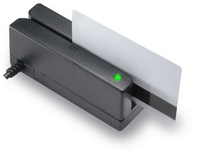








A magnetic stripe card is a type of card capable of storing data by modifying the magnetism of tiny iron-based magnetic particles on a band of magnetic material on the card. The magnetic stripe, sometimes called swipe card or magstripe, is read by swiping past a magnetic reading head. Magnetic stripe cards are commonly used in credit cards, identity cards, and transportation tickets. They may also contain an RFID tag, a transponder device and/or a microchip mostly used for business premises access control or electronic payment.
In 1969 Forrest Parry, an IBM engineer, had the idea of securing a piece of magnetic tape, the predominant storage medium at the time, to a plastic card base. He became frustrated because every adhesive he tried produced unacceptable results. The tape strip either warped or its characteristics were affected by the adhesive, rendering the tape strip unusable. After a frustrating day in the laboratory, trying to get the right adhesive, he came home with several pieces of magnetic tape and several plastic cards. As he walked in the door at home, his wife Dorothea was ironing clothing. When he explained the source of his frustration: inability to get the tape to "stick" to the plastic in a way that would work, she suggested that he use the iron to melt the stripe on. He tried it and it worked.The heat of the iron was just high enough to bond the tape to the card.
In most magnetic stripe cards, the magnetic stripe is contained in a plastic-like film. The magnetic stripe is located 0.223 inches (5.66 mm) from the edge of the card, and is 0.375 inches (9.52 mm) wide. The magnetic stripe contains three tracks, each 0.110 inches (2.79 mm) wide. Tracks one and three are typically recorded at 210 bits per inch (8.27 bits per mm), while track two typically has a recording density of 75 bits per inch (2.95 bits per mm). Each track can either contain 7-bit alphanumeric characters, or 5-bit numeric characters. Track 1 standards were created by the airlines industry. Track 2 standards were created by the banking industry (ABA). Track 3 standards were created by the Thrift-Savings industry.
Magstripes following these specifications can typically be read by most point-of-sale hardware, which are simply general-purpose computers that can be programmed to perform specific tasks. Examples of cards adhering to these standards include ATM cards, bank cards (credit and debit cards including VISA and MasterCard), gift cards, loyalty cards, driver's licenses, telephone cards, membership cards, electronic benefit transfer cards (e.g. food stamps), and nearly any application in which value or secure information is not stored on the card itself. Many video game and amusement centers now use debit card systems based on magnetic stripe cards.
Magnetic stripe cloning can be detected by the implementation of magnetic card reader heads and firmware that can read a signature of magnetic noise permanently embedded in all magnetic stripes during the card production process. This signature can be used in conjunction with common two factor authentication schemes utilized in ATM, debit/retail point-of-sale and prepaid card applications.
Counterexamples of cards which intentionally ignore ISO standards include hotel key cards, most subway and bus cards, and some national prepaid calling cards (such as for the country of Cyprus) in which the balance is stored and maintained directly on the stripe and not retrieved from a remote database.